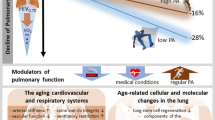Abstract
Respirator masks vary in inhalation and exhalation resistance, and in dead volume. It is believed that these factors may contribute significantly to an early anaerobic threshold in mask wearers during maximal exercise. Very little is known concerning the effect of respirator masks on maximal oxygen consumption\((\dot VO_{2max} )\) and the lactate threshold (LT). The purpose of the present study was to assess peak\(\dot VO_2 \) \((\dot VO_{2peak} )\) LT and the ventilatory threshold (VT) of 14 experienced cyclists performing two maximal cycle exercise protocols while wearing a full respirator mask (FM) (M17 type) and a mouth mask (MM).\(\dot VO_{2peak} \) was 10% lower under FM conditions. Peak values for ventilation\((\dot V_{Epeak} )\), respiratory rate (f bpeak) and tidal volume (V Tpeak) were all significantly lower under with FM versus MM conditions. Performance time and maximal heart rate (f cpeak) were not different between mask conditions. The LT and VT when expressed in %\(\dot VO_{2peak} \) and the lactate concentration (mmol · l−1 at LT and VT were not significantly different across mask conditions. Bland-Altman plots demonstrated longer inhalation times, decreasedf r values and greater oxygen extraction under FM conditions. Thus, perhaps due to the increased inhalation resistance of the FM condition, subjects were unable to attain their “normal”\(\dot VO_2 \) despite similar performance times and maximalf c. Furthermore, despite a diminished\(\dot VO_{2peak} \) with FM, LT and VT appeared to be the same as with a MM.
Similar content being viewed by others
References
Bland J, Altman D (1986) Statistical methods for assessing agreement between two methods of clinical measurement. Lancet (No. 8476) I:307–310
Caiozzo V, Davis C, Ellis J, Azus J, Vandagriff R, Prietto C, McMaster C (1982) A comparison of gas exchange indices used to detect the anaerobic threshold. J Appl Physiol 53:1184–1189
Cerretelli P, Rajinder S, Farhi L (1969) Effect of increased airway resistance on ventilation and gas exchange during exercise. J Appl Physiol 27:597–600
Dressendorfer R, Wade C, Bernauer E (1977) Combined effects of breathing resistance and hyperoxia on aerobic work tolerance. J Appl Physiol 42:444–448
England P, Powers S, Dodd S, Callender T, Brooks E (1984) The effect of acute thermal dehydration on blood lactate accumulation during incremental exercise. J Sports Sci 2:105–111
Harber P, Tamimie J, Emorym J, Bhattacharya A, Barber M (1984) Effects of exercise using industrial respirators. Am Ind Hyg Assoc J 45:603–609
Hermansen L, Vokac Z, Lereim P (1972) Respiratory and circulatory response to added air flow resistance during exercise. Ergonomics 15:15–24
Jette M, Thoden J, Livingstone S (1990) Physiological effects of inspiratory resistance on progressive aerobic work. Eur J Appl Physiol 60:65–70
Johnson A, Cummings E (1975) Mask design considerations. Am Ind Hyg Assoc J 36:220–228
Johnson A, Dooly C (1994) System to obtain exercise respiratory flow waveforms. Comput Methods Programs Biomed 42:27–32
Johnson A, Grove C (1993) Respirator mask design modules and their interactions. Am Ind Hyg Assoc J 54:749–751
Johnson A, Dooly C, Dotson C (1995) Respirator mask effects on exercise metabolic measures. Am Ind Hyg Assoc J 56:467–473
Louhevaara V, Smolander J, Tuomi T, Korhonen O, Jaakkola J (1985) Effects of an SCBA on breathing pattern, gas exchange, and heart rate during exercise. J Occup Med 27:213–216
Mitchell J, Sproule B, Chapman C (1958) The physiological meaning of the maximal oxygen intake test. J Clin Invest 37:538–547
Reinhard U, Muller P, Schmulling R (1979) Determination of anaerobic threshold by the ventilation equivalent in normal individuals. Respiration 38:36–42
Sucec A, Tucker S, Ponton L, Macy R (1982) The reproducibility of the anaerobic threshold by venous blood lactate and gas exchange measurements. Med Sci Sport Exerc 14:127
Sucec A, Ponton L, Tucker S, Macy R (1988) Validity of gas exchange indices as a measure of anaerobic threshold on the treadmill. In: Dotson C, Humphrey J (eds) Exercise physiology: current selected research, vol 1. AMS, New York, pp 31–43
Taylor H, Buskirk E, Henschel A (1955) Maximal oxygen uptake as an objective measure of cardiorespiratory performance. J Appl Physiol 8:73–80
Author information
Authors and Affiliations
Rights and permissions
About this article
Cite this article
Dooly, C.R., Johnson, A.T., Dotson, C.O. et al. Peak oxygen consumption and lactate threshold in full mask versus mouth mask conditions during incremental exercise. Europ. J. Appl. Physiol. 73, 311–316 (1996). https://doi.org/10.1007/BF02425492
Accepted:
Issue Date:
DOI: https://doi.org/10.1007/BF02425492




